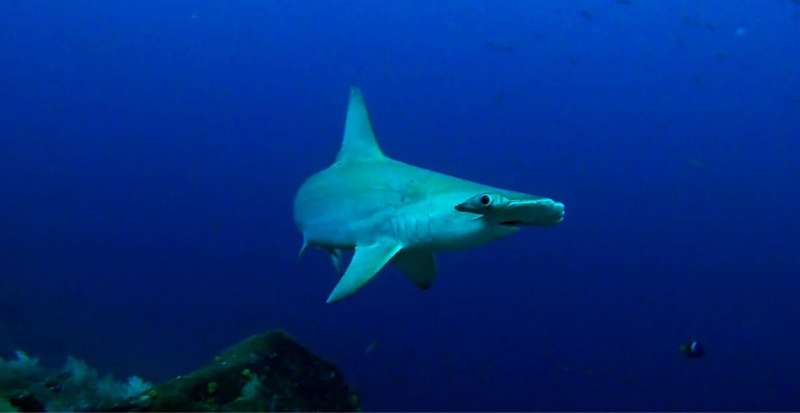This article has been reviewed according to Science X's editorial process and policies. Editors have highlighted the following attributes while ensuring the content's credibility:
fact-checked
peer-reviewed publication
trusted source
proofread
Study clarifies that marine protected areas are managed with climate change in mind

Scientific findings don't always translate neatly into actions, especially in conservation and resource management. The disconnect can leave academics and practitioners disheartened and a bit frustrated.
"We want conservation science to be informing real-world needs," said Darcy Bradley, a senior ocean scientist at The Nature Conservancy and a former director of University of California Santa Barbara's Environmental Markets Lab.
"Most managers and practitioners also want to incorporate science into their work," added Cori Lopazanski, a doctoral student at UCSB's Bren School of Environmental Science & Management.
Lopazanski and Bradley were particularly curious how much science was finding its way into the management plans of marine protected areas, or MPAs. These are areas of the ocean set aside for conservation of biodiversity, cultural heritage and natural resources.
The pair led a study investigating the management plans for 555 marine protected areas to clarify how the documents incorporated recommendations for climate resilience. The team found that many plans contain forward-looking strategies, even when they didn't explicitly reference "climate change" or related terms. The results appear in the journal Conservation Letters.
This is the first study to examine this question in detail on an international scale. The authors considered marine protected areas of various sizes, locations and layouts across 52 countries, with plans written in nine languages. Their list included practically any marine reserve that barred extractive activities at least somewhere within its borders, including the Channel Islands National Marine Sanctuary, just off the coast of Santa Barbara.
Previous studies mostly focused on the explicit language of management plans. This literal approach gave the appearance that marine protected areas weren't being managed effectively for climate change. In contrast, Lopazanski, Bradley and their co-authors searched the plans for strategies that promote resilience.
The results appear worrying at first. Just over half of the plans in the study did not explicitly include strategies to tackle climate change impacts. In fact, about 22% didn't mention climate change at all. "You could mistakenly draw the conclusion that we have a long way to go to really prepare the world's MPAs for climate change," Bradley stated. However, a more holistic review revealed a different picture.
Management plans overwhelmingly contained key principles for building resilience, even when they didn't explicitly mention climate change. Roughly speaking, 94% outlined long-term objectives, 99% included threat-reduction strategies, 98% had monitoring programs, and 93% incorporated adaptive management.
Adaptive management evolves to keep up with changing circumstances. It's a continual process of evaluating what is and is not working, and correcting course to keep on target. It begins with setting objectives for the area: conservation goals, species and communities of interest, etc. Managers then assess what's happening in the area to develop strategies to meet these goals.
The objectives and assessment then inform the MPA's design, including its size, shape and location. Once it's established, monitoring can begin to track indicators for the objectives. With a clear goal and active observation, managers can implement strategies and interventions, such as addressing pollution, removing invasive species, and restoring habitat.
Adaptive management offers dynamic protection. "We don't have a ton of evidence about which types of climate strategies are going to be most effective well into the future because climate change impacts are a moving target," Bradley said. So she was thrilled to see how many management plans incorporated principles of adaptive management.
Managing with the future in mind is particularly important in our changing world. In a recent study, Lopazanski and her colleagues found that marine heat waves impact ecological communities regardless of whether they are protected inside an MPA. The results raise the question of whether marine protected areas will remain effective conservation tools.
Lopazanski believes this critique misses the point. Marine protected areas will experience losses under climate change just like protected areas on land. That doesn't mean these parks, reserves and sanctuaries aren't worthwhile. "There are some things that marine protected areas do really well," she said. They're particularly effective at mitigating the impact of fishing and other extractive activities. That's why MPAs have to be one part of a more comprehensive conservation and management plan for our ocean biodiversity and marine resources.
What's more, large marine heat waves are a relatively new phenomenon, and dealing with that uncertainty is part of designing an effective MPA. "It's easy to criticize MPAs as a static strategy, ill-suited to deal with the dynamic nature of climate change," Bradley said, "But a deeper look at the plans reveals that they are more dynamic than they appear."
The authors compiled many different management strategies in the paper, highlighting some they think are underutilized. They also peppered the study with examples and lessons from different MPAs.
They were particularly impressed by the management plan of the Greater Farallones National Marine Sanctuary, off the coast of San Francisco. Its comprehensive plan included diverse strategies that targeted different climate change impacts and challenges facing that specific region. "This study can be a resource for managers who are looking to make their MPAs more resilient," Lopazanski said.
In fact, utility was one of the study's key aims. This research was a collaboration between academic scientists and conservation practitioners. It was intentionally designed to gather information that would be immediately actionable and useful for real-world MPA management. A document to bring academics and managers just a bit closer together.
More information: Cori Lopazanski et al, Principles for climate resilience are prevalent in marine protected area management plans, Conservation Letters (2023). DOI: 10.1111/conl.12972
Journal information: Conservation Letters
Provided by University of California - Santa Barbara




















